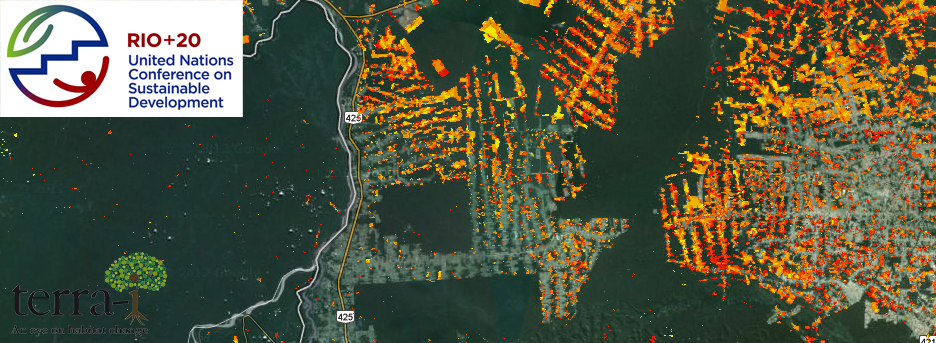

Terra-i, a system for near real time land cover or habitat change monitoring over Latin America, was launched during the Rio+20 conference in Brazil. Mark Mulligan, of King’s College London, Louis Reymondin Ph.D supervisor, showed the power of the tool and potential applications during the multiple “Dialog days” held during the conference.

Terra-i, a system for near real time land cover or habitat change monitoring over Latin America, was launched during the Rio+20 conference in Brazil. Mark Mulligan, of King’s College London, Louis Reymondin Ph.D supervisor, showed the power of the tool and potential applications during the multiple “Dialog days” held during the conference. After the official post by the King’s College London entitled “Deforestation tracker Rio+20 launch”, the launch of Terra-i received widespread media interest:
- “A New Satellite Tool Tracks Deforestation” – by The New York Times;
- “First Satellite Deforestation Tracker For Latin America Shows Tree-Felling Has Risen By 340%” – by The Huffington Post UK;
- “Watch Deforestation from Space” - by Discovery News;
- “First Satellite Deforestation Tracker for Whole of Latin America” – by ScienceDaily;
- “Terra-i: the most precise real-time deforestation tracker yet” – by arstechnica.com;
- “Terra-i tracks deforestation across Latin America in near real-time” – by wired.co.uk;
- “Deforestation tracker Rio+20 launch” – by EarthSky.org;
- “Scientists develop first satellite deforestation tracker for whole of Latin America” – by Phys.org;
- “Sistema de satélites vai monitorizar florestas da América Latina (Satellite system will monitor Latin America forests)” – Ciênciahoje.pt;
- “Terra-i, un preciso seguimiento en tiempo real de deforestación de bosques y selvas (Terra-i, an accurate real-time deforestation monitoring of forests and jungles)” - by wwwhatsnew.com;
- “Terra-i, la deforestación bajo la lente (Terra-i, deforestation under lens)” – by eleconomista.mx;
- “Wycinanie Amazonii nie tylko w Brazylii (Cutting the Amazon, not only in Brazil)” - by Gazeta.pl
As well as a favorable response from Rio+20 delegates, the Terra-i website received lots of new subscribers and 3000 visitors in one day. Many shared the map visualization tool on social media networks (Twitter, Facebook and Youtube). Also, we have received lot of e-mails with suggestions and feedback that have been valuable for improving the tool.
It’s also important to highlight the user’s role in the project. As Dr. Mulligan said to The New York Times, “The best way to improve a system is to get people to use it”.
For further information about Terra-i news, publications and data downloads visit:
Finally, Terra-i team would like to thank Karolina Argote, who recently left her position at the team, for her amazing work and dedication to the project. She played a fundamental role in the team and her invaluable contributions will help us continue to develop and refine Terra-i in the future.
Originally post in DAPA blog: http://dapa.ciat.cgiar.org/terra-i-strong-response-to-tools-launch-during-rio20/

The Terra-i team together with CRS El Salvador under the Raices project carried out a virtual workshop through the teams platform to technicians from the Ministry of Environment and Natural Resources, CARITAS, Universidad El Salvador, CENTA, about the Mapping of land cover using remote sensors and open source tools such as GEE, SEPAL and QGIS- Plugin Semi Automatic Classification.

Near real-time vegetation loss detection in Southwestern Ethiopia: calibration, validation, and implementation of the Terra-i system

The Alliance of Bioversity International and the International Center for Tropical Agriculture (CIAT) (the Alliance) conducted a training for local stakeholders on the use of Terra-i as part of the collaboration with the Netherlands Development Organisation – SNV in the Coffee Agroforestry and Forest Enhancement for REDD+ (CAFÉ-REDD) Project.


From May 8-12, 2017, the Terra-i team, together with staff from the DGOTA of Peru's Ministry of Environment, carried out the first field validation of vegetative land cover changes detected during Terra-i monitoring for 2016 and 2017, using the technology UAV. This work was carried out under the framework of the project “Sustainable Amazonian Landscapes”. The team carried out over-flights with a Phantom 3 advanced rotor drone and a fixed-wing Ebee drone in seven townships of Yurimaguas. The objective of this work was to recognize the dynamics of land cover and land use changes in the region while at the same time to validate the accuracy of the detections of forest loss being monitored by Terra-i in Yurimaguas.

The Terra-i team has worked hard on renovating Terra-i’s website since early this year. A set of new features on the website provides interactive contents and facilitates adaptation to the mobile devices of our users. The fresh website was developed using the latest update of an open-source, Java-based web system, Magnolia CMS 5.4.4. This update was customized to add different categories of interaction such as news, vegetation cover changes, and information, among others.

Globally more than 1 billion people depend on forests for their livelihoods. Forests play a crucial role in climate regulation, ecosystem services provision and regulation, water supply, carbon storage and many other functions that support biodiversity. Currently the global rate of deforestation is substantial, and there is a growing need for timely, spatially explicit data that flag natural vegetation changes due to human activities.

The latest update of Terra-i has been used with the Co$ting Nature ecosystem services assessment tool to understand the impacts of recent forest loss in Colombia on biodiversity and ecosystem services.

During the 1st and 12th of June 2015, the Terra-i team, together with the Instituto de Investigaciones de la Amazonía Peruana (IIAP) and the Universidad Nacional Agraria La Molina (VLIR-UNALM), conducted the second field validation of the data produced by the Terra-I system. This time, the study area was the Yurimaguas district, Alto Amazonas province, Loreto region (Peru). We used information on populated places, main roads, rivers and information on land cover changes detected for 2013, 2014 and 2015 to define the 65 sampling points (or Terra-I pixels) for the validation process (Figure 1).